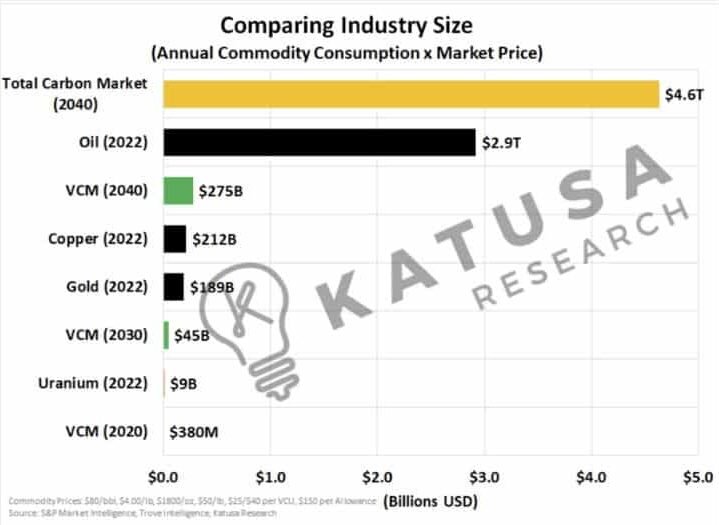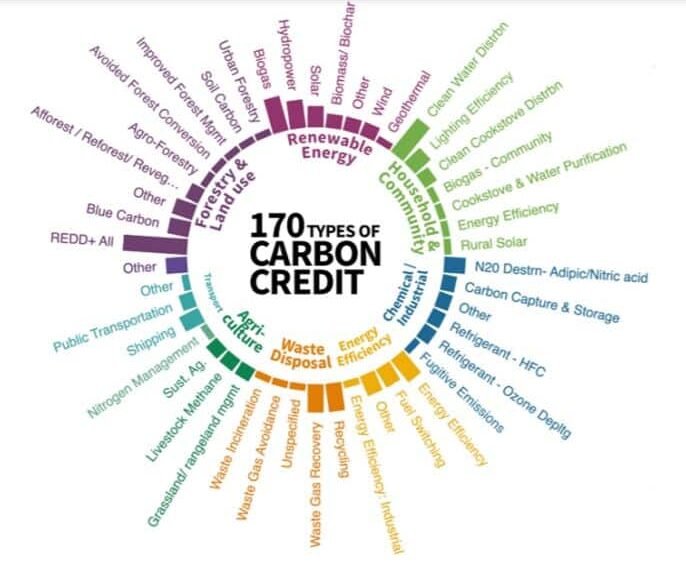Retiring carbon credits can be a powerful tool for individuals and businesses to offset their carbon emissions and contribute to a greener future. By retiring these credits, we can ensure that the emissions reduction achieved is permanent and not double-counted, creating a more transparent and effective carbon market.
This approach not only helps combat climate change but also encourages the development of sustainable practices and technologies.
If you’re into knowing about how the process works, this article will explain everything you need to know about carbon credit retirement. Let’s begin by explaining how these credits work.
Understanding How Carbon Credits Work
Carbon credits are tradable certificates that give entities the right to emit a tonne of CO2 or its equivalent. They are generated by projects that reduce or remove CO2 from the atmosphere like planting trees.
The credits serve as a permit, allowing the holder to neutralize their emissions. In that way, they work like renewable energy certificates (RECs) which are also a market-based instrument that certifies the holder owns a megawatt-hour of electricity from a clean energy source.
Essentially, RECs are a type of carbon credit alongside many others. These credits come in two major categories: compliance and voluntary markets.
In the voluntary carbon markets, carbon credits are also called offsets. Emitters voluntarily bought them to offset their greenhouse gas emissions.
In the compliance markets, businesses’ emissions are ‘capped’. If they go beyond that cap or limit, they’re fined or they can buy carbon credits corresponding to the amount of their excess emissions.
The Lifecycle of a Carbon Credit
Retiring carbon credits involves a series of stages. But let’s focus on the last three crucial steps that ensure the integrity of the credits, the process of trading them, and what it means to retire them.


The verification process is critical for ensuring the accuracy, transparency, and integrity of reported project data. Verifiers have to confirm a project’s compliance with the carbon program’s eligibility criteria. They validate the collection of project monitoring data as per program requirements and verify the accuracy of emissions reduction calculations based on approved methodologies.
After a project has undergone the verification processes, it becomes eligible for registration within the program. In other words, the credits they generate are now available for trading.
Carbon credit trading has become very popular today among individuals and organizations and various carbon exchanges began to emerge. This is happening for a simple reason: Reducing GHG emissions is a global initiative and the carbon market offers great opportunities for entities seeking to cut their emissions.
You can buy or trade carbon credits for retirement purposes through various platforms. There are a couple of online carbon credit marketplaces and spot exchanges to choose from.
Here are the top four carbon exchanges this 2024 that you can consider. You can also try popular marketplaces like the one that Salesforce launched or that of Alcove’s.
Lastly, let’s move toward the end goal of carbon credit trading – retirement.
The Retirement Process Explained
Carbon credit retirement also means their death.
A carbon credit is retired once its benefit has taken place. That means it has been used and the carbon benefit it represents has been claimed by the entity that bought it.
Retiring your carbon credits requires you to ensure that they are removed from the marketplace and labeled as ‘retired’ in any records or registry. The retired credits must serve their emission reduction purpose only once to prevent double counting.
Take note that retirement only occurs once the impact has happened. This means retiring your carbon credits depends on what type of credit you purchase.
If you’ve bought ex-post carbon credits, you can retire them right after your purchase. You can then instantly get the proof of retirement.
For ex-ante and pre-purchase carbon credits, retiring them won’t happen immediately after you bought them. That’s because their impact hasn’t yet occurred and their retirement should be in the future. You should know when the timeline would be from the seller or the marketplace where you purchase the credits. It may take months or even years, depending on the specific project you invest in.
Impact and Benefits of Retiring Carbon Credits
By buying carbon credits, entities help fund efforts that support decarbonization elsewhere. These initiatives often yield positive benefits to the environment and local communities. More importantly, each credit retired helps quantify the actual environmental impact of those projects.
When it comes to the impact of retiring carbon credits on investors, be it individuals or companies, it has two major effects.
First, it preserves the integrity and effectiveness of emission reduction projects. It prevents double counting or reusing of the credits by multiple entities. This further guarantees transparency and accountability in the carbon markets.
In effect, carbon credit retirement instills confidence among companies regarding the impact of their purchases or investments.
Thus, secondly, retiring carbon credits helps build a good reputation and enhance brand value of your company. Take for instance the case of large businesses supporting various carbon reduction projects.
Giant technology companies like Microsoft and Apple have been investing millions in carbon offsets from projects that either reduce or sequester carbon from the atmosphere.
As they do that, they’re not only addressing their emissions but also dealing with their corporate sustainability.
The Role of Carbon Credits in Corporate Sustainability
So, how do carbon credits become the new currency of ESG investing to meet environmental obligations and corporate sustainability?
In the U.S., the coin of the realm is dollars while in the EU, it’s Euro. In the ESG world, it’s the carbon credit. Carbon credits are taking a small space on the ESG goals of businesses.
But as more companies are pledging to reach net zero, these credits are also gaining more momentum in ESG investing to ramp up carbon emission reductions. And slashing emissions has now become a critical element of corporate and environmental responsibility to help fight climate change.
Corporations use carbon credits to reach their net zero, carbon neutrality, or carbon negative goals. As such, research firms estimated that the carbon market will grow as much as 30x more by 2030. If that happens, the market will be as huge as the NASDAQ stock market by the decade’s end.
According to the independent firm Katusa Research, the overall carbon market (compliance and voluntary) could be on equal footing as the oil market.

The burning of fossil fuels emits carbon dioxide, contributing to climate change. Different corporate climate goals mean different things.
Achieving carbon neutrality means balancing emitted and removed CO2. Daily actions like driving emit CO2, but walking or using renewables can reduce it. Carbon credit offsets fund CO2 removal projects.
Carbon negative goes beyond neutrality, removing more CO2 than emitted. For instance, Microsoft aims for carbon negativity by 2030, promising to remove all emissions since its founding. H&M and Ikea also strive for “climate positive,” akin to carbon negativity efforts. Their strategies involve sustainability investments and reduced emissions.
Best Practices in Carbon Credit Retirement
Now, that you know how carbon credits work, the importance of retiring them, and the processes involved, there’s one more thing left to keep in mind. What are the best practices to follow when retiring carbon credits?
We summarize them in two essential points: selecting the right carbon credit projects and transparent reporting of the retirement.
As mentioned earlier, there are plenty of projects generating carbon credits. There are 170+ of them as per the Ecosystem Marketplace report.


So, you must choose the ones that suit your purpose very well. If you’re into nature-based initiatives, you may pick from the different forestry and land use projects, i.e. REDD+. But if you’re operating in the power sector, you may want to go for renewable energy such as supporting solar or wind projects.
Regardless of your choice, be sure to be informed of the existing standards and methodologies for that project. This is crucial so that your carbon credit investment would count by actually reducing emissions. That entails being transparent in reporting your retirement.
Transparency is one of the biggest concerns plaguing the carbon market right now. Questions were raised as to the effectiveness of carbon projects in delivering their emission reduction promises. This caused a rapid decline in voluntary carbon credit prices, particularly the nature-based offsets.
Yet, current and future innovations in carbon credit markets show that they are here to stay and will continue to play a significant role in curbing GHG emissions.
The Future of Carbon Credits
Recent innovations such as the launch of insurance products that protect carbon credits indicate that the market is heading in the right direction. Application integration like the case between Alcove and Shopify is another important market development that tackles transparency in credit retirement.
The use of blockchain technology is also considered a solution to make carbon credit retirement easier to track. Add to this the big players entering the market to further address transparency in tracking the lifecycle of each credit. For example, the NASDAQ exchange launched an innovative technology to revolutionize the industry.
Nasdaq’s new approach uses smart contracts for secure transactions and promises to bring much-needed standardization to attract investors.
Moreover, announcements by countries to integrate carbon markets into national registries also suggest that trading and retiring carbon credits would become the standard in curbing emissions and fighting the climate crisis.
- SEO Powered Content & PR Distribution. Get Amplified Today.
- PlatoData.Network Vertical Generative Ai. Empower Yourself. Access Here.
- PlatoAiStream. Web3 Intelligence. Knowledge Amplified. Access Here.
- PlatoESG. Carbon, CleanTech, Energy, Environment, Solar, Waste Management. Access Here.
- PlatoHealth. Biotech and Clinical Trials Intelligence. Access Here.
- Source: https://carboncredits.com/retiring-carbon-credits-everything-you-need-to-know/



